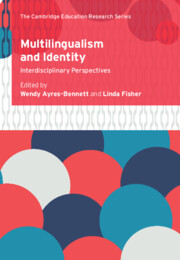Book contents
- Multilingualism and Identity
- Multilingualism and Identity
- Copyright page
- Contents
- Figures
- Tables
- Contributors
- 1 Towards Interdisciplinarity in Multilingual Identity Research
- Part I Situated Multilingualism and Identity
- 2 ‘Every Line Is a Lie’
- 3 Beyond ‘Narrating the Nation’
- 4 Metrolingual Practices and Distributed Identities
- 5 Migrants’ Identities in Multilingual Cities
- 6 Indexicalities in the Multilingual City
- 7 Multilingualism and Identity in Ningbo, China
- Part II Multilingual Identity Practices
- Part III Multilingual Identity and Investment
- References
- Index
2 - ‘Every Line Is a Lie’
The Geographical and Cognitive Mapping of Multilingualism and Identity
from Part I - Situated Multilingualism and Identity
Published online by Cambridge University Press: 22 July 2022
- Multilingualism and Identity
- Multilingualism and Identity
- Copyright page
- Contents
- Figures
- Tables
- Contributors
- 1 Towards Interdisciplinarity in Multilingual Identity Research
- Part I Situated Multilingualism and Identity
- 2 ‘Every Line Is a Lie’
- 3 Beyond ‘Narrating the Nation’
- 4 Metrolingual Practices and Distributed Identities
- 5 Migrants’ Identities in Multilingual Cities
- 6 Indexicalities in the Multilingual City
- 7 Multilingualism and Identity in Ningbo, China
- Part II Multilingual Identity Practices
- Part III Multilingual Identity and Investment
- References
- Index
Summary
This chapter examines the tensions inherent in how languages and identities are mapped geographically and cognitively, and the particular issues which multilingualism brings out in this mapping. Linguistic atlases require clear boundaries to be drawn within messy realities – a utopian undertaking with significant uses, which, on balance, may or may not outweigh the risks of declaring this or that language as belonging to, or dominant in, this or that place. There has in addition been a strong tendency to represent the cognitive dimensions of multilingualism and identity using the same mapping techniques developed in geographical representation, both with fMRI research and in recent work based on a crossing from geographical to cognitive (including emotional) representation, as multilingual children are asked to divide up and colour in an outline figure representing which of their languages represents which part of their personal identity. The aims of this chapter are to probe the ways in which multilingualism and identity are conceived and mapped, to establish the limits of their representation, and to enrich understanding of the linguistic phenomena which they are designed to capture.
Keywords
- Type
- Chapter
- Information
- Multilingualism and IdentityInterdisciplinary Perspectives, pp. 21 - 42Publisher: Cambridge University PressPrint publication year: 2022
- 3
- Cited by

